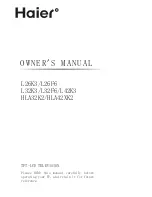
SMP 111 • Reference Information
91
Port Number
A port number is combined with the IP address to create an application‑specific or
process‑specific address. The port number can uniquely identify an application or process
on a computer and thereby enable the computer to share a single Ethernet connection
for multiple requirements. A port number is always associated with the IP address of the
computer, as well as the type of protocol used for network communication.
The SMP uses specific ports, but can be configured to meet most requirements. In addition
to the default ports, any port in the available range (1024 to 65535) can be used.
NOTE:
Ports previously assigned and currently in use by the SMP cannot be used
again.
All streaming methods (except TS/UDP push) use multiple port numbers. The following table
shows the number of ports used by each streaming method. Recording and streaming
streams have different port numbers.
RTSP (Pull)
TS/UDP
(Push)
TS/RTP
(Push)
ES/RTP
(Push)
Unicast
(per stream)
4
*
1
2
4
*
Multicast
4
*
1
2
4
*
*
4 ports for "Audio/Video", or 2 ports for "Video only"
When the SMP 111 ports are configured, only the initial port is entered by the user. The
SMP 111 firmware then assigns the multiple port numbers based on the initial port number.
Choosing an IP Address
If the SMP 111 and other devices are connected via an independent network, then follow
the guidelines below when choosing IP addresses. However, if the SMP 111 and other
devices are being connected to an existing network, advise the network administrator and
ask them to assign suitable addresses.
On an independent network, nearly any type of address can be used (in theory). However,
it is generally recommended that class C addresses are used (
192.0.0.1
through
223.255.255.253
).
There are two rules for choosing IP addresses:
•
The network identifier must be the same for each address.
•
The host identifier must be unique for each address.
Applying these rules to class C addresses, the first three decimal values of the IP addresses
must all be the same, while the last value is used to uniquely identify each device.
The table below shows an example of a valid class C addressing scheme.
Device
IP Address
Subnet Mask
Device 1
208.132.180.41
255.255.255.0
Device 2
208.132.180.42
255.255.255.0
Device 3
208.132.180.43
255.255.255.0
NOTE:
The host identifiers (
41
,
42
, and
43
in the example above) do not need to be in
sequential or in any particular order. However, it is recommended that the numbers
are grouped for simplicity.
Содержание SMP 111
Страница 1: ...User Guide SMP 111 Streaming AV Product Streaming Media Processor 68 2850 01 Rev C 11 17...
Страница 6: ......
















































